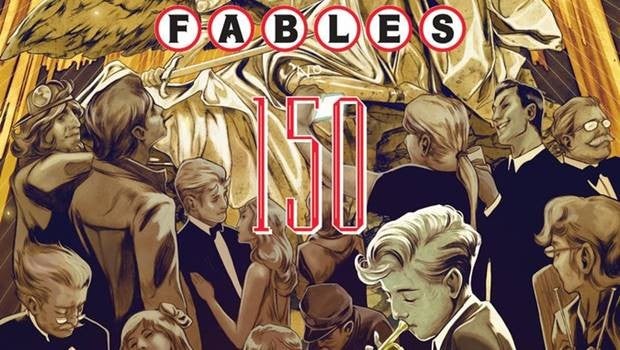Endings are difficult no matter what kind of story you’re telling. The longer a story goes, the more praise it wins, or the larger its audience grows only makes the creation of a great ending more difficult. So ending a series like Fables with 150 issues, 3 spin-offs, 14 Eisner Awards, and an audience estimated to be even larger than its sales show, isn’t just hard, it’s a truly monumental task. Fables #150 is a monumental issue though, weighing in at 130 pages and published in a prestige TPB format. It brings closure to this enormous tale, and manages to give readers what they really need after more than a decade of stories.
Videos by ComicBook.com
It doesn’t hurt that “Happily Ever After”, the lead-in to this volume was a low point for Fables (rivaled only by “The Great Fables Crossover”). It drug on over 9 issues pushing the series toward this round number, and killing a lot of characters unnecessarily along the way. That set up placed expectations far lower than necessary and saved all of the best action for the final issue, titled “Farewell”. With gratuitous exposition and place setting complete, Fables #150 picks up the pace and focuses on the heart of the series: its characters.
“Farewell” is divided into two halves of approximately equal length. The first section is the final issue, a continuous narrative sub-divided into chapters, that connects clearly to the preceding 149 issues. The back half is composed of more than a dozen epilogues, all titled “The Last _____ Story”, just like the one-shots found in the back of each issue of “Happily Ever After”. It is an extended epilogue, providing the necessary room to wrap up a universe filled with literally hundreds of characters.
There is a lot to resolve in the first half of Fables #150, much of which has been set up in the wake of Fables #75 when the war with the Homelands concluded. Bill Willingham takes most of the remaining plot threads and brings them to a concise and satisfactory ending place. There are some exceptions to this, specifically Geppetto whose 75 issue ongoing sub-plot is barely addressed. But Geppetto has never been an intrinsic part of this story after his initial defeat. The most important characters still lacking a resolution (i.e. Bibgy Wolf, Snow White, and Rose Red) all receive plenty of attention. This focus on three characters raises a mirror to the series very first story “Legends in Exile”, where these same three played the central roles.
The way the final confrontation between these three characters plays out is a bold choice. It is simultaneously massive and small, tense and reassuring. More than anything it is exactly what readers need, although it may not be what they want. A louder, longer battle may have provided more spectacle, but Mark Buckingham manages to cram plenty of that into a couple of dense, detailed spreads. The scope of this confrontation is more than sufficient, but it’s the emotional complexity and relationships that make it impactful. Here, Buckingham is also the star of the show. When it comes down to the final moments, he portrays faces and bodies with subtlety instead of melodrama. Readers are brought into the conversation and conflict, making it feel personal. That balance of the big and the small is what makes all of the best moments in Fables #150 work so well.
This doesn’t exclude opportunities to say goodbye to other significant Fables. King Cole, Flycatcher, and one supposedly dead (very carefully obscured) Fable all get very nice farewells along the way. Their final moments in the series avoid the maudlin and focus instead on who these characters are. Many completed complex character arcs long ago, and what they do serves as an epitaph of who they became, a final thought to remind us why we love these men and women.
At least one concluding moment fails to live up to this promise though. There’s some big noise made about midway through that results in more deaths that can only be read as gratuitous. They fail to reveal anything about the characters involved or factor into the final battle. This one scene brings back the worst elements of “Happily Ever After”. It tries to create stakes through deaths that do not reinforce what’s important to the story. They simply occur and then the page is turned. Buckingham’s work is the only redeeming factor to this sequence, making the action every bit as exciting and tense as the series best battles in stories like “March of the Wooden Soldiers” and “War & Pieces”. It’s a bit of grand spectacle laid atop, not integrated into, a functioning story.
The epilogues following the final battle compose a very necessary outro. They prevent a feeling of anti-climax and allow Willingham to write as many goodbyes as necessary without cramming them into the central plot. Fables is an enormous world with lots of characters, and these 1-6 page stories allow readers to take one final traipse through it all.
The “Last Stories” present a wide range of tones and suitable artistic talents along with them. They vary from the comedic to the dramatic to the expository (although most could be described as fun), each with a unique combination of pencilers, inkers, and colorists. Mike Allred, Joelle Jones, and Neal Adams each deliver unique takes on specific characters delivering a loving goodbye from truly tremendous talents.
It’s the very last “Last Story” that does it, though. This may technically be an epilogue, but it isFables’ true farewell, complete with the final “The End”. Resist any temptation to skip past other stories to reach this point because once you read it, it’s clear that Fables is over. Buckingham delivers the final panel in the form of a double barrel gatefold, filled with details and enhanced by snippets of choice dialogue from Willingham. It is beautiful, packed with detail, and lovingly rendered. This enormous panel is exactly what you need to see presented how you need to see it. Buckingham shows off the enormity of the story, and delivers both on the promise of the scope and emotional depth in Fables. The final line on the page is likely to induce tears too. I certainly wept.
And that’s happily every after. “Farewell” stands as a testament to the mighty legacy of Fables. It is every bit as large as the series that preceded it, and packs all of the feeling and skill that led Fables to so much success. It is not always a perfect goodbye, but such a thing may not even be possible for so great an undertaking. “Farewell” is perfect where it counts though. The final battle, the final panel, and the final line are all exactly what is needed. They are reminders of why Fables is so beloved, and are bound to linger fondly on the minds of its readers. In its final moments, Fables #150 summons the ethos of “Happily Ever After” as well as all of the fairy tales that inspired its creation.
Grade: B









